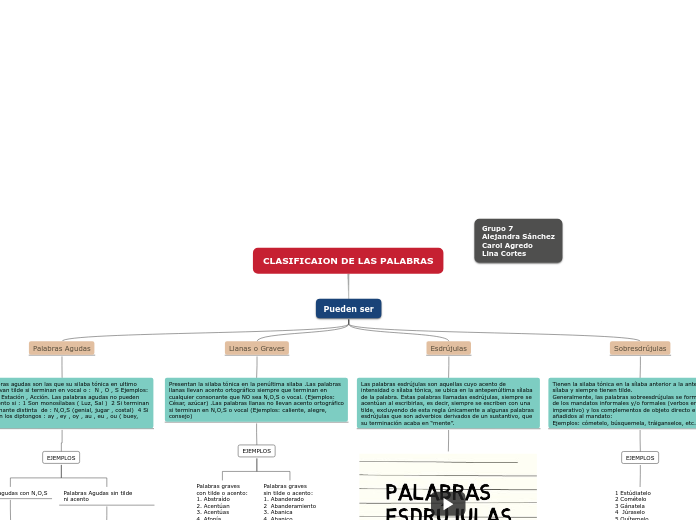Grupo 7 Alejandra Sánchez Carol Agredo Lina Cortes
CLASIFICAION DE LAS PALABRAS
Type in the name of the multiple-perspectives text.
Example: Bridge to Terabithia by Katherine Paterson
Pueden ser
Identify an important issue from the text that is being presented from different angles. Type it in.
Example: Jesse's drawing talent.
Sobresdrújulas
Decide on the fourth point of view
Type in the name of the last character whose perspective on the issue you are going to present.
Example: Leslie Burke, Jesse's new next-door neighbor, and best friend.
Tienen la silaba tónica en la sílaba anterior a la antepenúltima sílaba y siempre tienen tilde.
Generalmente, las palabras sobreesdrújulas se forman a partir de los mandatos informales y/o formales (verbos en modo imperativo) y los complementos de objeto directo e indirecto añadidos al mandato:
Ejemplos: cómetelo, búsquemela, tráiganselos, etc.
Point of view
Type in a relevant quote that highlights the character's point of view. Try to follow a citation format: author's name, chapter, and page.
Example: I can't get the poetry of the trees,' he said. She nodded. Don't worry,' she said. You will someday. He believed her.' (Paterson, 4. 24)
How is the viewpoint introduced in the story?
Choose an answer:
First person point of view - using the personal pronouns 'I' or 'we'Second person point of view - using the personal pronoun 'you'Third person point of view - using the third-person pronouns 'he', 'she' and 'they'Omniscient point of view - an all-seeing observer tells the story
1 Estúdiatelo 2 Comételo 3 Gánatela 4 Júraselo 5 Quítemelo
Esdrújulas
Whose character does the third point of view belong to?
Type in his/her name.
Example: Mr. Aarons, Jesse's father.
Las palabras esdrújulas son aquellas cuyo acento de intensidad o sílaba tónica, se ubica en la antepenúltima sílaba de la palabra. Estas palabras llamadas esdrújulas, siempre se acentúan al escribirlas, es decir, siempre se escriben con una tilde, excluyendo de esta regla únicamente a algunas palabras esdrújulas que son adverbios derivados de un sustantivo, que su terminación acaba en “mente”.
What does the character think, say or do that suggests their perspective on the issue?
Type in a quote and try to maintain the citation format.
Example: 'He would like to show his drawings to his dad, but he didn't dare. (...) He'd thought his dad would be pleased. He wasn't. What are they teaching in that damn school? he had asked.' (Paterson, 2.8)
Llanas o Graves
Decide on the second point of view
Name the character (it can either be the main character or one of the supporting characters) whose point of view you are presenting.
Example: Miss Edmunds, Jesse's music teacher.
Presentan la silaba tónica en la penúltima silaba .Las palabras llanas llevan acento ortográfico siempre que terminan en cualquier consonante que NO sea N,O,S o vocal. (Ejemplos: César, azúcar) .Las palabras llanas no llevan acento ortográfico si terminan en N,O,S o vocal (Ejemplos: caliente, alegre, consejo)
Type in a quote that points out the character's position about the issue.
Try to follow a citation format: author's name, chapter, and page.
Example: 'She said he was unusually talented, and she hoped he wouldn't let anything discourage him.' (Paterson, 2. 8)
How is the viewpoint introduced in the story?
Choose an answer:
First person point of viewSecond person point of viewThird person point of viewOmniscient point of view
Palabras graves
sin tilde o acento:
1. Abanderado
2 Abanderamiento
3. Abanica
4. Abanico
5. Acerado
6. Abuelo
Palabras graves
con tilde o acento:
1. Abstraído
2. Acentúan
3. Acentúas
4. Afonía
5. Agonía
6. Álbum
Palabras Agudas
Decide on the first point of view you are going to present.
Type in the name of the character (it can either be the main character or one of the supporting characters) whose point of view belongs to.
Example: Jesse Oliver Aarons, Jr., the main character of the novel, a fifth-grader living in a rural Southern area.
Las palabras agudas son las que su silaba tónica en ultimo lugar. Llevan tilde si terminan en vocal o : N , O , S Ejemplos: Huracán, Estación , Acción. Las palabras agudas no pueden llevar acento si : 1 Son monosílabas ( Luz, Sal ) 2 Si terminan en consonante distinta de : N,O,S (genial, jugar , costal) 4 Si acaban en los diptongos : ay , ey , oy , au , eu , ou ( buey, batey )
Type in a relevant quote that highlights the character's point of view towards
Pueden ser.
Try following a citation format: author's name, chapter, and page.
Example: 'Jesse drew the way some people drank whiskey. (...) Lord, he loved to draw. (...) When he was in first grade, he told his father that he wanted to be an artist when he grew up.' (Paterson, 2. 7)
EJEMPLOS
What type of narration introduces the viewpoint?
Choose an answer:
First person point of view - using the personal pronouns 'I' or 'we'Second person point of view - using the personal pronoun 'you'Third person point of view - using the third-person pronouns 'he', 'she' and 'they'Omniscient point of view - an all-seeing observer tells the story
Palabras Agudas sin tilde ni acento
1 Feliz 2 Reloj 3 Mujer 4 Español 5 Aprender 6 Universidad
Palabras agudas con N,O,S
1 También 2 Oración 3 Después 4 Café 6 Salió 7 Esquí









